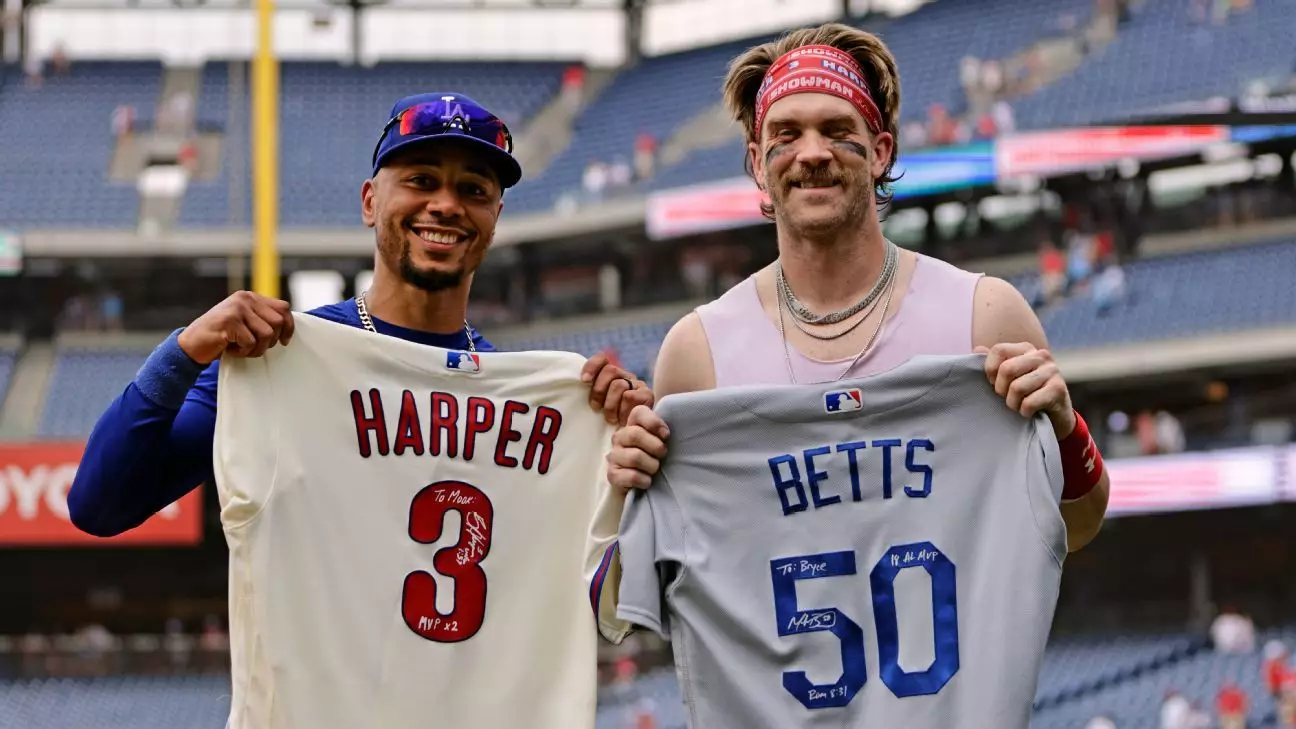In a world where the financial dynamics of sports have become as intriguing as the games themselves, the Los Angeles Dodgers stand out with an eye-popping payroll approaching $320 million. Bryce Harper, the Philadelphia Phillies’ formidable slugger, recently weighed in on this trend, expressing admiration rather than criticism for the Dodgers’ aggressive spending. Harper’s candid remarks come ahead of a three-game series between the Phillies and Dodgers, where the stakes stretch beyond the diamond to the very fabric of the game itself.
For Harper, the noise surrounding the Dodgers’ financial maneuvers is nothing but the grumbling of “losers.” This statement, while provocative, highlights a broader conversation about the relationship between money, talent acquisition, and competition in Major League Baseball (MLB). Instead of resenting the success of teams like the Dodgers, Harper advocates for a perspective that recognizes their achievements, a sentiment that reflects a growing acceptance of financial disparity in the league.
Money Talks: MLB’s Record Payrolls and the New Norm
The 2023 MLB season began with an average player salary eclipsing $5 million for the first time, signaling a significant shift in the financial landscape of baseball. The New York Mets, backed by Juan Soto’s monumental contract, led the league with a payroll of $322.6 million, just ahead of the Dodgers. This financial trend raises eyebrows, not only among fans but also within the league itself. The Mets and Dodgers’ spending sprees are symptomatic of a strategic business approach, one that prioritizes star power and immediate success.
Harper’s endorsement of these spending habits indicates a departure from traditional critiques of financial disparity. As teams invest heavily in talent, the competitive balance often becomes skewed, leading to questions about the potential need for a salary cap in MLB. Yet, as Harper suggests, perhaps it is better to focus on elevating individual team performance rather than lamenting the financial disparity.
The Impact of Deferred Payments: A Closer Look
While the large payrolls capture headlines, the intricacies of player salaries tell a more nuanced story. Deferred payments play a critical role in how teams manage their financial commitments. Take, for instance, Shohei Ohtani’s unique contractual situation, where his colossal $70 million salary impacts the present-day financial implications by being valued at a fraction due to future payout obligations. Such financial engineering is commonplace, allowing franchises significant wiggle room while still affording marquee players.
This method of salary management is not exclusive to Ohtani; several Dodgers players benefit from similar arrangements. These strategies contribute to a broader narrative regarding how MLB teams are redefining their financial strategies to cobble together competitive rosters. For players like Harper and his Phillies teammates, this means navigating a landscape where money can be both a bridge and a barrier to success.
The City of Angels: A Prime Destination for Talent
Harper’s admiration for Los Angeles extends beyond just the team’s financial prowess; he recognizes the city’s allure as a sports destination. Citing factors such as vibrant nightlife, diverse culinary experiences, and a rich sports culture, Harper points out the natural draw for players considering future contracts. The Dodgers’ ability to attract top talent goes beyond mere numbers; it’s about lifestyle and opportunity in one of America’s most iconic cities.
This cultural draw affects the dynamics of recruitment and player decisions, as stars are likely to choose teams that offer not only competitive salaries but also robust lifestyles. Harper’s assertion that Los Angeles remains a “mecca” for athletes underlines the often-overlooked aspects of player agency within the market—factors that can lead to a competitive imbalance but also foster the growth of the sport itself.
Looking Ahead: The Future of Competitive Balance
As MLB navigates the complexities of financial disparity, it’s apparent that the current model favors teams with deep pockets, creating challenges for franchises less willing or able to spend extravagantly. Commissioner Rob Manfred’s acknowledgment of fans’ concerns regarding competitive balance signals an ongoing dialogue about the foundational structure of MLB.
While Harper’s viewpoint may initially seem controversial, it can also serve as a catalyst for action. Players, franchises, and the league itself must reflect on how to ensure a level playing field while maintaining the excitement that comes with high-stakes competition. As the game evolves, so too must the frameworks that govern it—ensuring that all teams have a fair chance to compete, even amidst the financial giants like the Dodgers. The question remains: can MLB strike a balance between financial freedom and competitive integrity? The answer to that will shape the future of baseball itself.


Leave a Reply